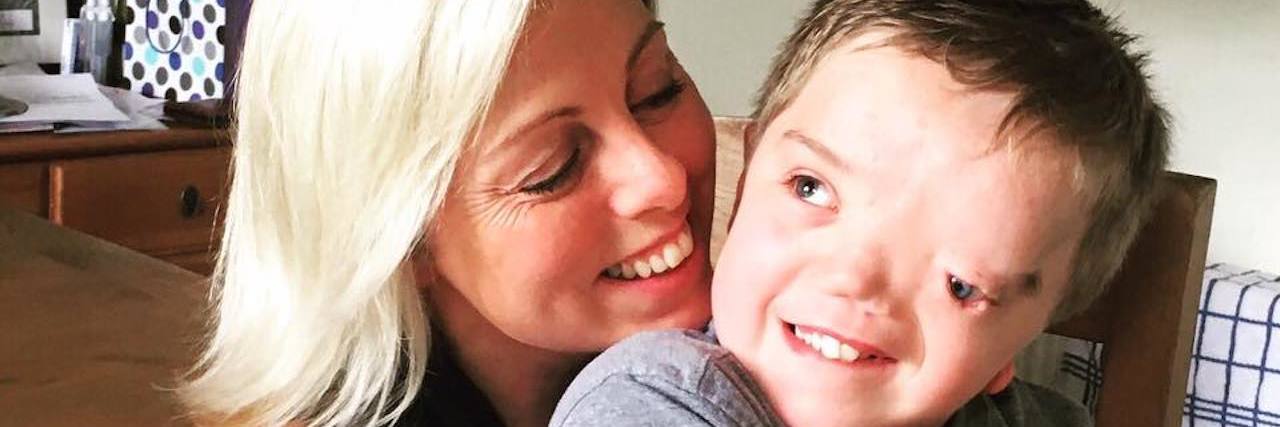When my twins were born prematurely, I had no idea Harry had a rare cranio-facial condition called Goldenhar syndrome. Taking my double buggy out always attracted a lot of attention and some very awkward moments when people peered into the buggy, saw my boy, and just didn’t know what to say. When my best friend, Caroline, convinced me to take the boys to soft play centers with her and her boys, I experienced the less restrained reaction of other children. Some would cry when they saw Harry. More than once, children shrieked and ran away. Once, a boy got Harry in a head lock and tried to force his “bad eye” to open. I never blamed the children for their reactions, but it really stung me to say the least.
Nowadays, I am really comfortable in dealing with people’s reactions and questions, so I thought I wold compile my top tips on the ways that you can help your own child understand facial disfigurement or physical differences in others.
1. Be proactive.
I imagine 99 percent of conversations with children happen in response to seeing someone with a facial difference (or even a disability, which can evoke similar questions and reactions). My top tip would be to chat about it now, even before you see someone who looks different to what typical children expect to see. There is no right or wrong age for this, as it very much depends on your own child, but once they are able to understand the difference between boys and girls, then I think it’s a good time to talk about other differences.
2. Model the right behavior.
I know this can be hard when people respond instinctively, but we are our children’s first teachers so it’s important we show them the best way to respond in all life situations. If you do see someone with a facial disfigurement, in a wheelchair etc., just smile. Don’t rush the child away or encourage them to look away. I think anyone who looks different for any reason is prepared for the variety of reactions we receive, so to see you explaining about diversity and sharing a smile is so much healthier than ushering children off and whispering as if we are something not to be looked at.
3. Show them images of children who look different.
Please, if you only do one thing after reading this, show your children some images of Harry and introduce them to him on the videos I share on our Facebook page. We have lots of children who send him messages and drawings who I am positive asked the first time they saw him why he looked different. But now, they simply see the boy he is. In showing children images of others who look different it makes them aware of those differences and opens their mind to see the similarities instead.
4. Help them to see the similarities.
This could be something the child is doing, if you are at the same place, then chat about the fact that they must also like the zoo, cinema or trampoline park. It could be something as simple as a color they are wearing that your child likes, or a bag of crisps they are eating. Think on your feet and find the common ground. There will always be more similarities than differences, but it can take a few minutes to find them.
5. Explain that some people simply look different.
It’s simply a fact that there are some children who are born with syndromes like Harry and who may look different to a typical child. There are also children and adults whose appearance may alter after an accident or illness. At some point, maybe when your children are a little older, it’s worth educating them that every face has a story. I don’t ever want anyone to pity Harry, but I want them to know that life is tougher with the world’s eyes on you and a smile can go a long way. Education and awareness promotes understanding and kindness.
6. Prepare an explanation.
In sales its called an “elevator pitch” — a summary of what you do in the amount of time that it would take to go from one floor of a building to the next. The more concise the better, and the more you practice it the more natural it feels. In a similar way, it’s a great idea to have a one-liner up your sleeve for the times when there might be an awkward moment to defrost or a very loud question from a little person to answer. For me, I always explained Harrys face by saying: “He was only born with one eye but some very clever doctors are making a new eye for him so that he looks like his brother and a bit more like you. He’s a very lovely boy and he likes bouncing, pizza and Thomas the tank. Do you like any of those things?” Know what you would say and you’ll find that you are able to deal with your natural embarrassment much better in the moments that count, rather than kicking yourself afterwards.
7. Focus on what matters.
Ironically, the best way to explain facial disfigurement is not to concentrate on it too much. If you find yourself in the position of needing to explain why some people look so different but you have your elevator pitch ready and have done some proactive ground work first, I guarantee that not only will you find it easier to explain, but your children will grow up accepting that difference is a part of life, and rather than being feared, differences can be celebrated. And maybe our kids will even pass that kindness on to the next generation.
For my son and for others like him, acceptance is the gift that just keeps giving. What an amazing thought that is!
Follow this journey at Our Altered Life.

